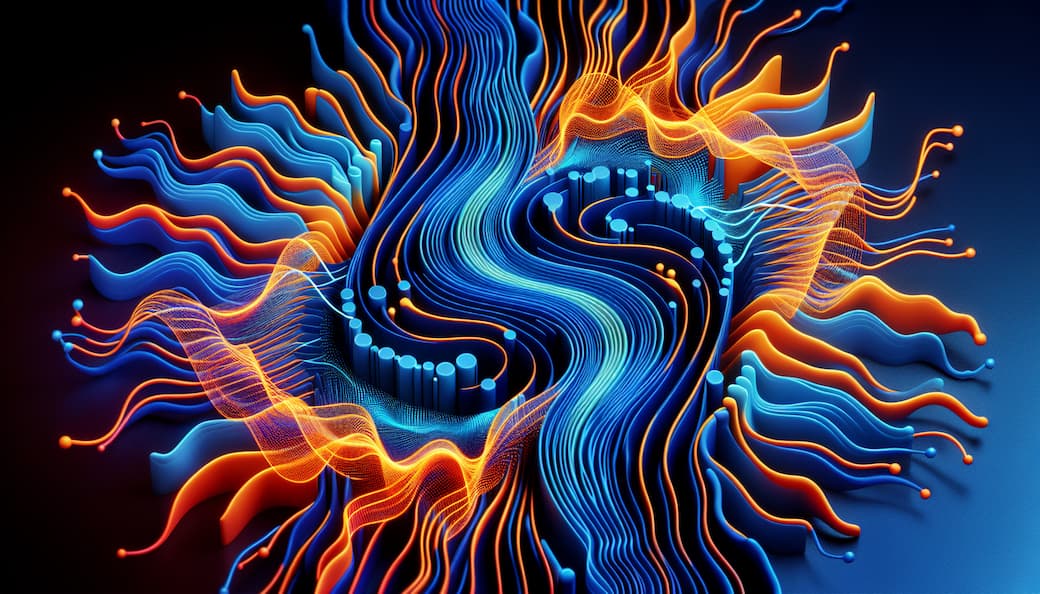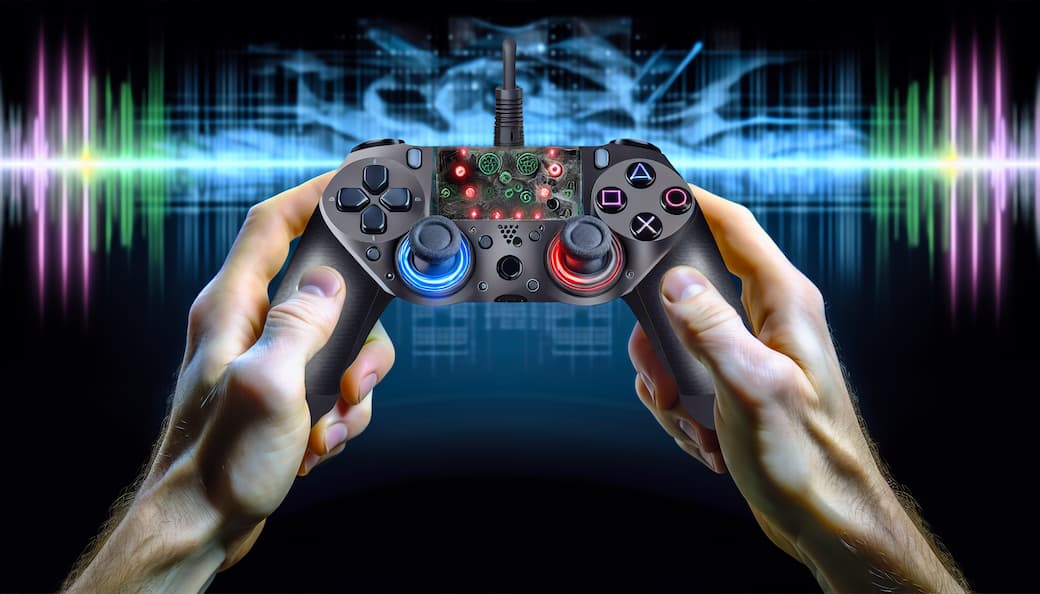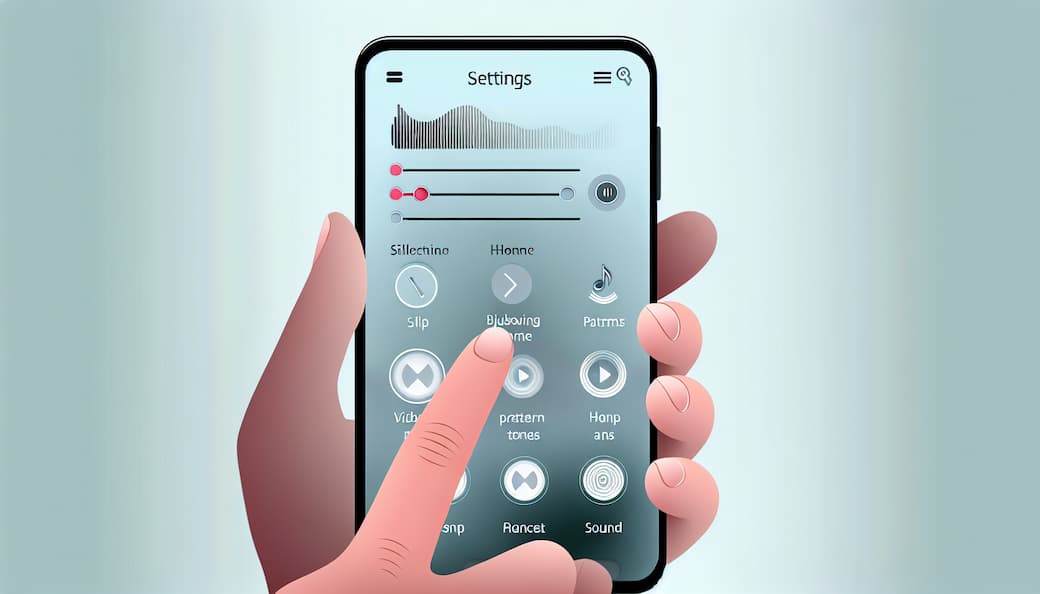
Sound Haptics: Feel Immersive Tactile Audio Feedback
Content
What sets sound haptics apart from ordinary vibrations on your devices? It’s the technology that enhances user experience by combining auditory and tactile feedback for a richer, more engaging interaction. This article unpacks sound haptics, explaining its operation and spotlighting its transformative role in everyday technology, all without revealing too much, so you can uncover its potential as you read on.
Key Takeaways
- Sound haptics technology enhances user experiences by using advanced vibration patterns to create a symphony of tactile sensations that accompany audio feedback, going beyond conventional single waveform vibrations.
- Applications of sound haptics span various industries including gaming, virtual reality, mobile devices, and the automotive sector, offering enhanced interaction, safety, and immersion.
- While customization of sound haptic settings on devices provides a more personalized user experience, the technology faces challenges like latency, power consumption, and hardware constraints, but can sometimes easily be triggered by sound.
Disclaimer: This article was generated by AI, but I corrected it to draw near to my high standards
Understanding Sound Haptics

Sound system haptics, is a fascinating fusion of audio and tactile feedback technologies. It is designed to create immersive experiences for users by engaging their tactile senses, often through sophisticated vibration patterns.
This innovative technology takes the monotony out of the regular vibrations we experience on our devices and replaces it with a symphony of sensations that can communicate a plethora of information and emotions. With system haptics, users can enjoy a more interactive and engaging experience.
The magic of sound haptics lies in its ability to transcend the boundaries of traditional vibrating devices. Sound haptics use advanced waveforms to convey a variety of information and sensations then scroll vibration on and off. This additional layer of tactile information, combined with audio feedback, brings us to the doorstep of an entirely new dimension of digital interaction. Let’s explore this further.
What is Sound Haptics?
Sound haptics go beyond the vibrations we feel when receiving an incoming call or text. It is a sophisticated form of technology that utilizes various vibration patterns to create an array of tactile sensations.
From gentle tap sounds we hear while typing on the screen with a smartphone keyboard, to intense vibrations we hear when mimicking gun recoil in video games, sound haptics can generate diverse and subtle tactile experiences.
The main purpose of this technology is to enhance user engagement with digital devices and environments. Haptics can even be considered a type of communication on its own, delivering a sign to what is happening around you.
But what scientific principles make it possible for such seamless integration between sound and touch? Let’s take a closer look at the underlying science behind this innovative technology.
The Science Behind Sound Haptics
The technology of sound haptics is both fascinating and complex. Haptic feedback, which relies on skin receptors and nerve pathways to convey tactile information, serves as the foundation for this innovative system. Through these haptic feedback interfaces, virtual environments can now simulate touch experiences with a heightened sense of realism.
A crucial element in maximizing the effectiveness of sound haptics lies in synchronizing various types of feedback: kinesthetic, tactile, spatial, and non-spatial. This synchronization ensures that users experience an integrated sensation between auditory cues and physical touch. Management latency plays a critical role in preserving the user’s immersive experience by minimizing delays between input and output responses.
Applications of Sound Haptics

The potential uses of haptic feedback through sound are both diverse and fascinating. Across various industries, such as healthcare, entertainment, and automotive, the impact of sound haptics is being felt in a multitude of ways.
In the field of healthcare, virtual patients allow medical students to practice their skills with lifelike sensations thanks to advancements in sound haptics technology.
For gamers seeking an immersive experience that feels closer to reality than ever before – whether it’s driving a fast car or battling enemies on distant planets – sound-based feedback has enhanced gaming and VR experiences for decades.
To truly create seamless user experiences across different types of media systems, synchronization between visual signals and corresponding sounds for tactile response is vital. A deeper look into some specific applications highlights how powerful this form of enhanced sensory input can be. Especially when starting off with game-changing breakthroughs within gaming itself.
Mobile Devices
The presence of sound haptics in your smartphone home screen is a clear example of its impact. These devices use such technology to provide tactile audio feedback for various functions on home screen, utilizing small motors that create vibrations to simulate different sensations.
In the realm of smartphones, touch-sensitive haptic technology responds to user inputs like taps and rotations. From scrolling through social media feeds to typing out messages, receiving this type of tactile feedback plays a crucial role in our interaction with these mobile devices. As our reliance on smartphones increases, so does the significance of sound haptics in enhancing digital experiences.
Gaming and Virtual Reality
The world of gaming and virtual reality has witnessed the evolution of sound haptics, which has now become a crucial aspect of user experience. Its humble beginnings in early arcade games as basic vibrations have given way to more advanced forms of sound haptics, such as force-feedback steering wheels.
With time, there is an entirely different scenario. Modern gaming controllers like PlayStation 5’s DualSense utilize voice coil actuators and adaptive triggers to produce complex vibration patterns that provide tactile feedback during gameplay. For instance, indicating collisions in racing games.
Moreover, the inclusion of haptic glove has taken immersion in the virtual world to new heights. Users can now feel the shape, size, and stiffness of tangible objects. But there isn’t necessarily a need for additional hardware. Meta understood this and acquired a company to make their SDK Meta Haptics Studio and Haptics SDK for Unity available for developers.
Automotive Industry
Haptic feedback is gaining traction in the automotive industry as it has shown its worth. Its main purpose here is to enhance safety and efficiency by providing informative touch inputs, improving driver focus. This technology can be found in various parts of vehicles like steering wheels and seatbelts, which deliver alerts or warnings to drivers.
Companies like Mercedes builds vibrating seats into their cars for entertaining purposes. This so-called 4D Sound comes on top of Dolby Atmos, which can be considered 3D Audio. So the additional dimension is the sounds haptics, also literally sometimes called a “butt shaker”. Read more on Automotive Audio.
After looking at data into different applications of sound haptics, now it’s necessary to learn more data on how we can personalize this audio technology on our own devices.
Customizing Sound Haptics on your devices

Customizing the sound haptics on your devices can greatly improve your user experience. Whether you are using an iPhone or Android, there are options to adjust the audio haptics settings for ringtones, alerts, and vibration patterns according to your preferences.
Personalizing these settings allows for a unique and immersive experience tailored specifically to meet individual needs. This includes adjusting overall volume with a slider for various sounds, ringtones and alerts, creating new vibration patterns specific to alert you to certain sounds like texts or calls, as well as customizing vibrations through Haptics settings on iPhones.
Now let’s explore how customization of sound haptics works on both iPhone and Android devices. By tweaking these haptic features with settings such as vibration intensity levels or creating personalized vibrations based on different types of notifications using advanced slider sliders in the settings menu, users will have greater control over their device’s responses.
iPhone Sounds and Haptics
iPhone users have a multitude of options to customize the sounds and haptics they hear on their devices. The Taptic Engine, which uses linear resonant actuator technology, provides precise feedback for vibrations. It sounds very obvious to just change the default alert to what you want to hear, but it can be much more complex than you’d thinkg. Like you also have the option to tap create to design your unique sound combinations.
Individual contacts can be assigned specific default ringtones or text tones so that incoming calls or messages are accompanied by personalized alerts. You can set a distinct tone to alert for new voicemail notifications. This feature allows iPhone users to significantly enhance their interaction with their devices by personalizing its sounds and haptics.
But what about those who use Android? Let’s explore the various possibilities available.
Android Devices
Android users can adjust their device’s default haptic settings according to their preferences settings. To modify vibration intensity on an Android phone, simply access Settings, tap on Sounds and Vibration, and then select Vibration Intensity.
Additionally, on Android devices you can create personalized alert vibrations for specific contacts by following these steps which may vary from the default alert menu:
- Open either Contacts or Phone app
- Choose the desired contact
- Tap ‘Edit’
- Personalize ringtone and vibration patterns
Customizing haptic options from your phone or home screen is a great way to make using your Android device and screen more enjoyable and tailored to your liking.
After exploring sound-based customization possibilities with haptics, the future challenges of this technology need attention.
Overall, haptics has a promising outlook, but there are some potential obstacles in its path such as maintaining synchronization between audio-visual-haptic elements and dealing with compatibility issues across different platforms. Alongside those factors, potential advancements like incorporating AI techniques, multi-modal feedback systems, and seamless integration into everyday objects could take the tactile user experience even further.
Challenges and Future Developments in Sound Haptics
The field of sound haptics has advanced greatly in recent times, but it still faces certain obstacles. Technical limitations such as latency, power usage and hardware constraints are major issues to be addressed.
For audio and tactile feedback to work cohesively in sound haptic systems, low response time is crucial since even the slightest delay can disrupt user experience significantly. Reducing the high energy consumption of these devices is a considerable challenge, especially when used with portable or wearable technologies that rely on battery power.
Incorporating haptic actuators into small devices like smartphones and wearables poses a hurdle due to their size and weight restrictions. Despite these challenges ahead, there are promising developments emerging that will revolutionize this field of technology.
Technical Limitations
The development and application of sound haptics are hindered by technical limitations. One major challenge is the delay, or latency, between an action and its corresponding feedback due to technological constraints.
Another significant obstacle for implementing haptic technology is the high power consumption of actuators used in providing tactile sensations through sound. This poses a particular issue for mobile devices with limited battery life and available power. Integrating complex mechanical components into smaller consumer electronics can also prove difficult.
Some sounds haptics devices such as Subpac or Woojer filter out the low-frequency content of your audio file to react on these audio wavesforms in realtime. The data adjust as plug and play without the need to scroll through any developer menus. But this workflow introduces some latency and the default trigger of when the sounds haptics is running into the mode alert sometimes can’t be changed.
Despite these challenges facing sound haptics, promising innovations are emerging that aim to overcome these obstacles and advance the field further.
Emerging Innovations
Looking ahead, the future landscape of sound haptics holds numerous promising innovations. For instance, new methods for synchronizing haptic feedback and visual signals have been developed that do not rely on timestamps, improving user experience through enhanced synchronization.
Further, advancements in electromagnetic feedback and haptic actuation technology are critical for realistic feedback in haptic training suits used in simulations across various fields. Innovations in haptic feedback technology are being applied to bionic prostheses, providing tactile feedback for a natural sense of touch and muscle control.
For me the combination of audio and virtual reality is a big deal, you can read more of the benefits of VR Sound here. But those two senses of what you hear and see happen inside our hide. I was surprised to also feel by body being immersed into virtual worlds with a vibrating bagpack.
These emerging developments are set to redefine the boundaries of sound haptics and expand its potential applications.
Summary
As our exploration of sound haptics comes to a close, it is evident that this technology is not just a futuristic idea, but an innovative development that has already revolutionized our digital encounters. Through the utilization of advanced vibration patterns and waveforms, sound haptics provide an immersive experience unlike anything we’ve seen before by engaging users’ senses in new and powerful ways.
Despite its obstacles such as latency problems, energy consumption concerns, and hardware limitations, sound haptics continues to progress with emerging innovations promising to expand the limits of this technology. As we peer into the future possibilities for sound haptic advancements, Blurring the line between virtual and physical realities while transforming how we interact with technology on a whole different level beyond imagination.
Frequently Asked Questions
What is sound haptics for?
Sound haptics provides tactile feedback through electronic devices, such as notifying the user of received notifications or an incoming call, with vibrations or force feedback. This technology can also render auditory and haptic sensations using sounds as a physical model of virtual objects or data.
What are haptics on an iPhone?
Haptics on an iPhone is the technology responsible for providing tactile feedback, including subtle sensations and vibrations, when users interact with the device’s interface. This can encompass functions like Haptic Touch and receiving haptic feedback while typing.
Should system haptics be on or off on iPhone?
Whether you choose to have system haptics enabled or disabled on your iPhone is entirely up to personal choice. If you find it beneficial and pleasurable, then keeping the system haptics feature on would be advised. If you do not see any value in it, turning off this option can easily be done through your phone’s settings menu.
What does play haptics in silent mode mean?
When your iPhone is in silent mode, it will give you tactile response through vibrations as you tap sounds when you interact with the device. This includes tapping icons and using the keyboard. You can turn on this feature by going to Settings > tap iPhone Sounds > Haptics menu.
What is sound and haptics?
Sound and haptics are a technique used to create the auditory and physical sensations of virtual objects by simulating their sound and force. This is achieved through real-time calculations using specialized software that utilizes a physical model of these virtual objects.
Back to the BlogRelated Articles
VRTonung learning - THE spatial audio course for immersive media
Martin Rieger (VRTonung) - Interview VDT-Magazin
MPEG-H Audio vs. "Dolby Atmos" - there is a winner!
The Great 3D Audio Content Overview: inspiring demo examples
New car sound technology with Automotive Audio and 3D speakers